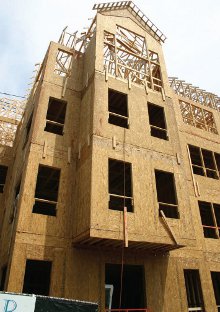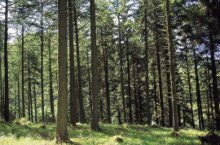Between the drought and the flood
2 May 2013With the US housing market now trending more firmly upwards, higher demand and prices for OSB have prompted several producers to commit to re-opening shuttered mills in 2013-14. No mills reopened in 2012, but OSB production still reached its highest level since 2008.
The improvement in production last year prompted one investment analyst to call the forthcoming two years 'the sweet spot between the drought and the flood'.
The recovery of the US housing market has been stuttering, at best, over the past two years or so. In fact, it had begun to look as though North American OSB producers might be waiting a long time before they could put the worst behind them, re-open mothballed mills, and look forward once again to profits being the measure of a company's performance, not how well management preserved its core business while vigorously slashing costs.
In recent months, however, there has been a definite shift in the US residential construction market, which drives OSB demand, production and prices - all of which were firmly on the up in the first two months of 2013. Not only have producers been talking this year of re-opening shuttered mills, several have actually announced plans to do so.
North American structural panel production in 2012 reached its highest level since 2008, according to quarterly statistics released in January by APA-The Engineered Wood Association in Tacoma, Washington.
Total structural panel production from the US and Canada in 2012 was 27.785 billion ft2, up 6.5% from 2011's total of 26.079 billion ft2, bolstered by a nearly 30% increase in housing starts.
North American OSB production in 2012 was 16.780 billion ft2, up 9.6% from 15.305 billion ft2 in 2011, according to APA, which noted this was again the highest yearly total since 2008, when production had reached 18.51 billion ft2.
Of that 16.780 billion ft2 total, US production of OSB in 2012 increased to 11.038 billion ft2 from 10.039 billion ft2 in 2011, while Canadian OSB production was 5.742 billion ft2, up from 5.266 billion ft2 in 2011, the APA statistics showed.
Apparent North American consumption of plywood and OSB increased 7.1% between 2011 and 2012, to 27.122 billion ft2. The US consumed 8.796 billion ft2 of plywood in 2012, and 14.063 billion ft2 of OSB, compared with a respective 8.718 billion ft2 of plywood and 12.628 billion ft2 of OSB in 2011.
Housing will lead the way in 2013
Setting the tone for that welcome surge in demand, of course, is the long-awaited turnaround in the US housing market.
It is estimated that every 100,000 housing strand lumber (OSL), and Ainsworth's second line at Grande Prairie, Alberta, when it is completed and goes on line, will have production capability for OSL, laminated strand lumber (LSL) and OSB.
Prospects for reviving new mill plans
Most of the proposed new OSB mills announced in the halcyon days of the early 2000's have fallen by the wayside. This time last year, there were four 'definite-maybes' on our list of new and proposed projects, two of which - GP's Clarendon County mill and Ainsworth's second line at Grande Prairie - have been covered earlier in this report.
Huber's plan, announced in 2006, to build a US$280m OSB plant in Georgia's Emmanuel County was put on hold because of market conditions, but has never actually been publicly ditched.
Little has been heard about the proposed project since mid-2010, when local newspaper The Forest-Blade in Swainsboro, Georgia, reported that the Swainsboro/Emanuel County Joint Development Authorities were going to ask the Emanuel County Commission to assist with the defeasance of US$2.5m in bonds set aside for the proposed plant. The defeasance of bonds renders such bonds null and void.
That news item, dated June 14, 2010, noted that Huber had invested more than US$9m in the project in land purchase, environmental studies, planning and site preparation before putting it on hold. The Forest-Blade quoted Brian Carlson, president of Huber Engineered Woods, saying the company still saw Swainsboro as "an ideal location for an OSB mill," but he said Huber could not move forward with a new plant until economic conditions improved. Carlson was quoted as saying Huber fully supported the decision of the Joint Development Authorities "to cancel the bond that was designed to pave the way for our arrival".
The fourth project that was still (barely) alive at the time of this report last year was Arizona Forest Restoration Products (AZFRP)'s plan to build a 650 million ft2/year OSB mill near Flagstaff, Arizona that would have been entirely dependent on US federally-controlled forests for its wood fibre.
We can, with confidence, state that that project - announced in November 2006 - has now officially bitten the dust, because AZFRP has been dissolved.
AZFRP wrangled with officials for six years, whipping up quite a flurry of support for a facility touted as a potential partial answer to the efficient use of forest fuels that pose such a threat of catastrophic wildfires in the dry US Southwest.
Over the years, responses from the ceo for updates on AZFRP's proposed OSB mill became hard to obtain and we noted in this report last year that the chances of the western US having its own OSB mill any time soon were looking ever more remote.
On June 4, 2012, AZFRP posted an announcement on its website saying it was dissolving the company. It cited the decision of the US Forest Service to award the Four Forest Restoration Initiative (4FRI) contract to Pioneer Associates on May 18, 2012.
AZFRP's understandably bitter statement noted: "Apparently, our proposal to fund landscape-scale restoration in northern Arizona with the safe deployment of proven technologies in proven regional markets was judged to offer a lesser value and higher risk to the government than our competitor's plan to experiment with cellulosic biodiesel.
"The reason for AZFRP to exist was to develop, advocate, bid on, win, and ultimately implement, the 4FRI restoration contract. Without such a contract, AZFRP has no reason to exist. The board of directors of AZFRP therefore made the decision on June 1, 2012 to proceed with the immediate dissolution of Arizona Forest Restoration Products Inc".
The fact the Arizona project's ultimate demise was caused not by the disastrous housing market, but by a wood fibre sourcing issue, will come as no surprise to those industry veterans who said in 2006 they would not want to invest mega-millions in a manufacturing facility that would be so heavily dependent on the government to feed it.
Prognosis looking good
For those still in the OSB game, the prognosis is looking a great deal better at the start of 2013 than it looked a year ago.
Forest industry investment analyst, Paul Quinn, of RBC Capital Markets, said in a couple of OSB research notes earlier this year he expects North American OSB mills to produce 19.2 billion ft2 in 2013 with US housing starts at the 950,000 level, for an effective operating rate of 93%, adding:
"Given that mills typically don't run above 92%, the market will be hand-to-mouth until the supply chain is able to rebuild inventories in 2014".
Quinn called the long-term fundamentals of the OSB industry "compelling", adding: "We like the concentrated industry structure of the North American panel sector (top five producers representing 77% of capacity and 82% of 2011 production). We continue to believe the industry will be rational in bringing back idled capacity and we expect prices to remain at highly profitable levels throughout 2013".
Around the same time, in a research note on Norbord, Vertical Research Partners analyst James Armstrong was equally bullish about the prognosis for the OSB sector for the next couple of years.
"Given the long [and increasing] lead times to re-start and ramp up capacity in OSB, we cannot figure out how enough capacity can come on line over the 2013-14 timeframe to keep up with demand and continue to believe capacity will not outstrip demand until well into 2015," said Armstrong.
"As such, we continue to believe pricing for wood products, especially OSB, will remain very strong, at least until closer to 2015, when there is at least some potential [for] a flood of new capacity to come online."

